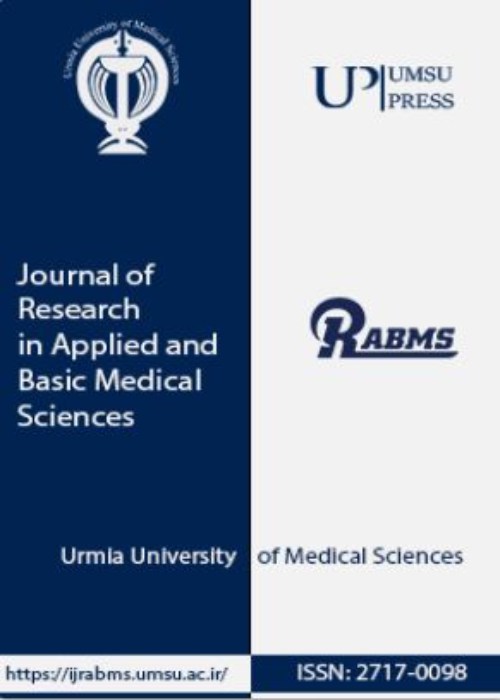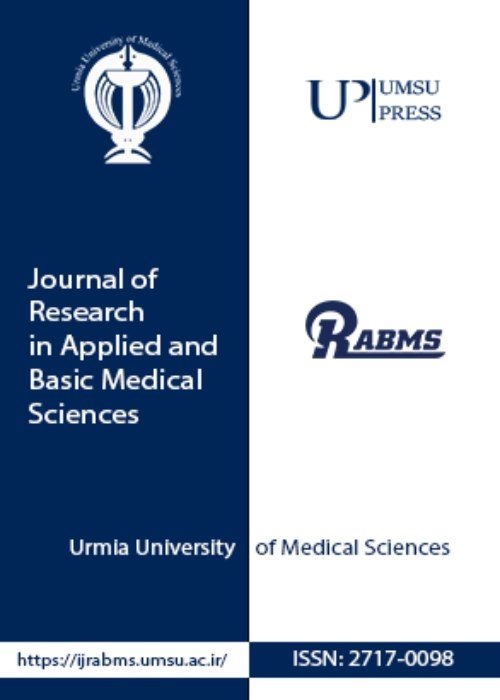فهرست مطالب

Journal of Research in Applied and Basic Medical Sciences
Volume:8 Issue: 2, Spring 2022
- تاریخ انتشار: 1401/02/11
- تعداد عناوین: 8
-
Pages 56-63Background & Aims
People with diabetes, exhibit increased platelet reactivity. Both insulin resistance and insulin deficiency increase platelet reactivity. Platelets play a vital role in the pathogenesis of acute coronary syndromes (ACS). It has been shown that PC and MPV are independent predictors for poor outcome in primary intracerebral hemorrhage. The aim of the study is to analyze the platelet parameters in patients with some non-hematological disorders such as diabetes mellitus type 2, acute coronary syndrome, and acute ischemic stroke.
Materials & MethodsBlood samples were collected from 400 subjects and analysed using the Sysmex KX-21 automated hematology analyser. 300 patients presenting with non-hematological disorders and 100 age and sex matched healthy controls were checked for Platelet indices such as PC, MPV, PDW and P-LCR. The platelet morphology was studied on peripheral blood smear for considering the arrangement, granularity and size of platelets.
ResultsIn total non-hematological disorders, DM type 2 accounts 37.33% (n=112), followed by 35.67% of ACS (n=107), and 27% of AIS (n=81). In diabetes mellitus type 2, PC was statistically elevated along with MPV compared with healthy controls. MPV and PDW were significantly raised in the patients admitted with ACS. In acute ischemic stroke, we noted that there was an elevation in MPV and a decrease in PC compared to them in the control group. Study showed discrete arrangement of platelets in 90% of DM type 2, 88% of ACS, and 80% of AIS patients. PBS in various clinical conditions showed granularity of platelets in 84 % of DM type 2, 81% of ACS and 83% of AIS patients. Study showed increased percentage of macrothrombocytes as 60% of DM type 2, 56% of ACS and 52% of AIS patients. The percentage of large platelets on PBS was increased beyond normal limits in DM type 2, ACS and AIS cases, indicating that there is an increase in size of the platelets supporting an increase in MPV.
ConclusionThe measurement of platelet indices may provide useful diagnostic and prognostic information to emergency physicians caring for patients with ACS and AIS.
Keywords: Platelet Indices, Acute Coronary Syndrome, Diabetes Mellitus, Acute Ischemic Stroke -
Pages 64-68Background & Aims
The placenta has been described as the most accurate record of the infant’s prenatal experience. The present study was a quantitative study and it was carried out to see the effect of pre-eclampsia on histopathology of placenta and the comparative changes in placenta of preeclamptic patients taking antihypertensives.
Materials & MethodsA total of 60 patients were selected from the Obstetrics and Gynecology Department of Jawahar Lal Nehru Medical College & Hospital, AMU, Aligarh, UP, India and were grouped into control, untreated, and treated groups. Placenta of each group was fixed in 10% formalin solution and processed for section cutting. 5-micron thick sections were prepared and stained with Hematoxylin-eosin and Wiegerts & Van gieson stain and observed under the light of the microscope. A total of 200villi/hpf was counted and percentages for each parameter were expressed.
ResultIt has been shown that there was a significant reduction (<0.05) in the percentage of placental villi showing syncytial knot, cytotrophoblast proliferation, Basement membrane thickening, fibrinoid necrosis, and stromal fibrosis.
ConclusionIt has been concluded that antihypertensive drugs were not only effective in controlling the symptoms of pre-eclampsia but also effective in minimizing the placental histopathology and helpful in continuation of pregnancy under low utero-placental flow without completely normalizing the placental changes.
Keywords: Pre-eclampsia, Methyldopa, Chorionic villi, Basement membrane -
Pages 69-74Background & Aims
One of the significant steps in the preformulation of pharmaceutical dosage forms is to examine active pharmaceutical ingredient (API) compatibility with the excipients applied with it. Drug-excipient incompatibility affects the stability, effectiveness, safety, and quality of the final product. Therefore, it is vital, for fruitful drug production, to sort out excipients compatible with the active pharmaceutical ingredient. The aim of this study was to evaluate the compatibility of ampicillin with lactose through differential scanning calorimetry (DSC) and Fourier-transform infrared spectroscopy (FTIR) physicochemical methods.
Materials & MethodsTo formulate powder samples, 300 mg ampicillin and lactose powder was discharged into a vial in a ratio of 1: 1, and 20% v/w water was added and then vortexed. Also, samples of pure drug and pure excipient were prepared by the same method. The direct compression method was applied to formulate the tablet samples. The samples were stored at 60° C in the oven and possible incompatibilities were examined for four consecutive weeks by observing the DSC thermograms and FTIR spectra.
ResultsAccording to the results, it is recommended to eschew the formulation of ampicillin with lactose for possible incompatibilities.
ConclusionBased on the obtained results and the changes in the main peaks of absorption of the drug-excipient mixture in the fourth week compared to the first day, there is the possibility of incompatibility in the mixture of ampicillin and lactose. Also, the observation of discoloration in the powder and tablets in the fourth week compared to the first day indicates the occurrence of a kind of incompatibility in the drug-excipient mixture.
Keywords: Incompatibility, Ampicillin, Lactose, Differential scanning calorimetry, Fourier-transform infrared spectroscopy -
Pages 75-82Background & Aims
As the first randomized clinical trial, this study evaluated the effect of Famotidine on the improvement of outcomes of hospitalized patients with COVID-19.
Materials & MethodsThis phase III randomized clinical trial which was designed with two parallel arms, is a placebo-controlled, single-blind, and concealed allocation study, and recruited 20 patients (10 of them received Famotidine as treatment group and 10 received Placebo as control group). Oral Famotidine 160 mg four times a day was given to the COVID-19 patients until the discharge day or for a maximum of 14 days. Patients’ temperature, respiration rate, oxygen saturation, lung infiltration, lactate dehydrogenase (LDH) level, and complete blood count (CBC) were measured at the baseline (before the intervention) and on day 14 after the intervention or on discharge day. Length of stay in the hospital and length of stay in the ICU were also measured as secondary outcomes of the study.
ResultsThe results showed a significant decrease in LDH (P=0.01), mean WBC (P=0.04) and length of stay (P=0.04) of patients with COVID-19 in the group treated with Famotidine compared to the control group. There was also a significant increase in oxygen saturation (P=0.01) in the group treated with Famotidine compared to the control group. Cough improvement was also higher in the oral Famotidine group compared to the control group (P=0.02).
ConclusionThis was the first clinical trial on the effect of Famotidine on the improvement of hospitalized COVID-19 patients, which indicated that high-dose Famotidine improves patients’ clinical signs and reduces the severity of the disease and duration of hospitalization.
Keywords: Famotidine, COVID-19, Hospitalization -
Pages 83-89Background & Aims
The present study aimed to determine the prevalence of impacted third molar as well as impaction angulation and depth.
Materials & MethodsIn this cross-sectional descriptive study, 261 panoramic radiographs belonging to patients visiting dental clinics and offices in Ghaemshahr, Iran, were evaluated and the presence of impacted wisdom teeth was examined. Moreover, the angulation of impacted teeth, impaction depth, and the relationship of the tooth to the mandibular ramus were recorded. The data were recorded, collected, and statistically analyzed in SPSS 22 using the non-parametric chi-square test. p <0.05 was considered significant.
ResultsOf the 261 patients entering the study, 52 (17.69%) had at least one impacted tooth. Of the total number of patients with impacted teeth, 31 were women (mean prevalence of 19.87% of the total population of women) and 21 were men (15.22% of the total population of men), showing no significant difference (p=0.29). In terms of impaction depth based on Pell and Gregory’ classification, Class C impaction depth was the most prevalent in the maxilla, while Class A was the most prevalent in the mandible. The most prevalent impaction in terms of angulation in relation to the second molar was vertical in the maxilla and vertical and mesioangular in the mandible.
ConclusionBased on results, the prevalence of impacted wisdom teeth in patients was 17.69%. This may not be a striking amount, but it is still of significance since the possible complications of impacted teeth are costly and problematic.
Keywords: Wisdom tooth, Tooth impaction, Panoramic radiography -
Pages 90-96Background & Aims
The aim of this study was to evaluate serum lipid profile and compare their levels between the patients with oral submucous fibrosis (OSMF) and oral squamous cell carcinoma (OSCC).
Materials & MethodsThis descriptive study was done in two groups of patients; OSMF and OSCC patients. There were forty-five participants in each group. Serum samples obtained from centrifugation of 12 hour fasting blood samples was analyzed by fully automated analyzer Beckman coulter AU-680 for estimation of the lipid levels (cholesterol, triglycerides (TGL), and high‑density lipids (HDL)) using colorimetric methods. Low‑density lipid (LDL) values were obtained by calculation.
ResultsThe comparison of lipid profile between Oral Submucous Fibrosis and Oral Carcinoma cases shows statistically significant results for TC, HDL and LDL.
ConclusionThe change in lipid levels may have an early diagnostic or prognostic role in oral premalignant and malignant lesions.
Keywords: Oral Submucous Fibrosis, Oral Squamous Cell Carcinoma, Serum Lipid Profile -
Pages 97-103Background & Aims
Social media/mobile mass communications, while providing an unprecedented capacity for the masses to communicate, has also been a major drivers in the rise of fringe opinions very damaging to public health. Reconciling principles of freedom of speech with the usage of social media for damaging falsehoods remains a conundrum for nations. Hence it was desired to conduct a study with objective of determining the influence of social media on the perception of COVID-19 vaccine.
Materials & MethodsAn analytical cross-sectional study was conducted from May - July 2021 (duration three months) on those who gave consent and were eligible for vaccination according to the guidelines by ICMR (Indian council of medical research) and GOI (Government of India)
ResultThe majority of study participants 76.7% were aware of covid appropriate behaviour and preventive measures and around 61.8% of participants were aware of covid vaccination.
The vast majority of the participants stated that they had obtained information about vaccinations (61.8%). The preferred method for acquiring information was social media (56.6%), followed by community health workers (15.6%), media-internet/news/television (15.3%) and very little importance to national guidelines through miking, pamphlets (5.6%).ConclusionThe impact of social media on the influence of covid vaccination was very disturbingly negative as a vast majority of study participants 60.7% tried to convince people to avoid vaccines after hearing about adverse events following vaccination through the social media platform.
Keywords: COVID-19 vaccine, social media, perception, hesitancy, impact -
Pages 104-109Background & Aims
This study has the objective to examine the resistance of the clinical isolates of Acinetobacter lwoffii to antibiotics.
Materials & MethodsThe samples, that were isolated from the patients admitted to Gazi Hospital in Turkey, were defined by the MicroScan 5 WalkAway Identification System (Siemens, Germany) in terms of species and were thus collected. Then, the resistance pattern of 10 isolated A.lwoffii strains was assessed to 11 antibodies and four antibiotic compounds in this study.
Results50% of the strains were found to be Multidrug-Resistant (MDR). Tigecycline was proved to be the most effective antibiotic with 80% sensitivity and 10% intermediate sensitivity.
ConclusionThe MDR A.lwoffii strains were observed in the clinical isolate of Gazi hospital patients. Hence, the identification and investigation of the model of antibiotic resistance of the microorganisms is necessary.
Keywords: Acinetobacter lwoffii, Multidrug-Resistant, antibiotic resistance


